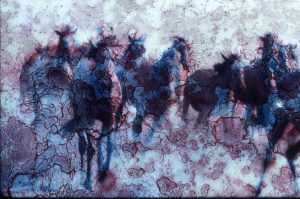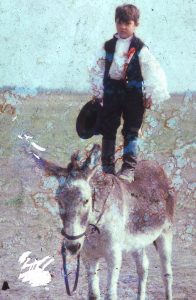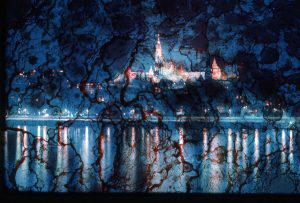
During the month of May there was an exhibition of some exceptionally engaging work by Peg Johnston. She is one of the founding members of Cooperative Gallery 213, an innovative artist run exhibition space that was seminal in creating the arts district in Binghamton, NY twenty one years ago.
A brilliant eye for objects, images and craft of the past and present, Johnston stumbled upon some Kodachrome slides taken by her uncle, Walter Wittman, while he was visiting Hungary in 1974. The slides were discovered within a vast amount of inherited ephemera and included landmarks in Budapest, modern day Huszárs, and their highly trained horses. (Huszárs or Hussars are equestrian warriors dating to the 15th century.)
 These discovered images were altered by natural deterioration. Photothermal denaturing of the film’s emulsion layers caused patterns, shapes, translucent blotches and veins of unexpected leaching: cyan and blues, magenta and reds, and variation in all the colors of the spectrum that Kodachrome was so stellar at capturing. The images were affected by heat, light, and time. And maybe a little dirt. This denaturing totally redefined any narrative formerly depicted in the originals. What were once tourist images are now impressionistic works, the images touched by atmospheric and emotional colors, rather than their once literal reality. Shapes, objects, colors are interrupted, overlaid, or lightly clouded over and create a reality that is at once historic—and yet mod. Johnston’s transformation of these images has created contemporary objects.
These discovered images were altered by natural deterioration. Photothermal denaturing of the film’s emulsion layers caused patterns, shapes, translucent blotches and veins of unexpected leaching: cyan and blues, magenta and reds, and variation in all the colors of the spectrum that Kodachrome was so stellar at capturing. The images were affected by heat, light, and time. And maybe a little dirt. This denaturing totally redefined any narrative formerly depicted in the originals. What were once tourist images are now impressionistic works, the images touched by atmospheric and emotional colors, rather than their once literal reality. Shapes, objects, colors are interrupted, overlaid, or lightly clouded over and create a reality that is at once historic—and yet mod. Johnston’s transformation of these images has created contemporary objects.

Physical and chemical forces affecting the film created something entirely unexpected and matchless. What time, heat, and light did to these 1970s vacation slides may have a scientific explanation, but the phenomena of the denaturing process is true alchemy. Johnston saved some slides from the trash and has given us a unique artistic experience.
by Mark Roth
Additional images and sales information is here.
